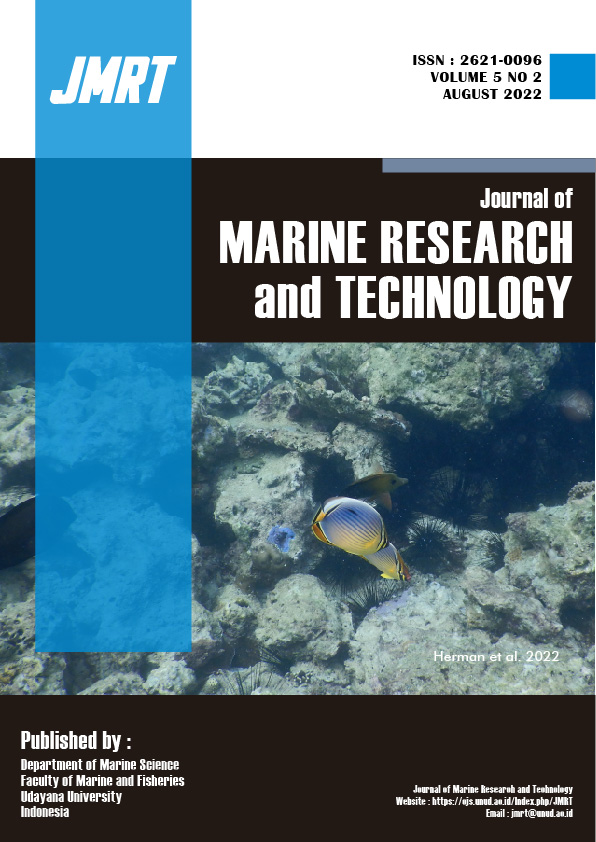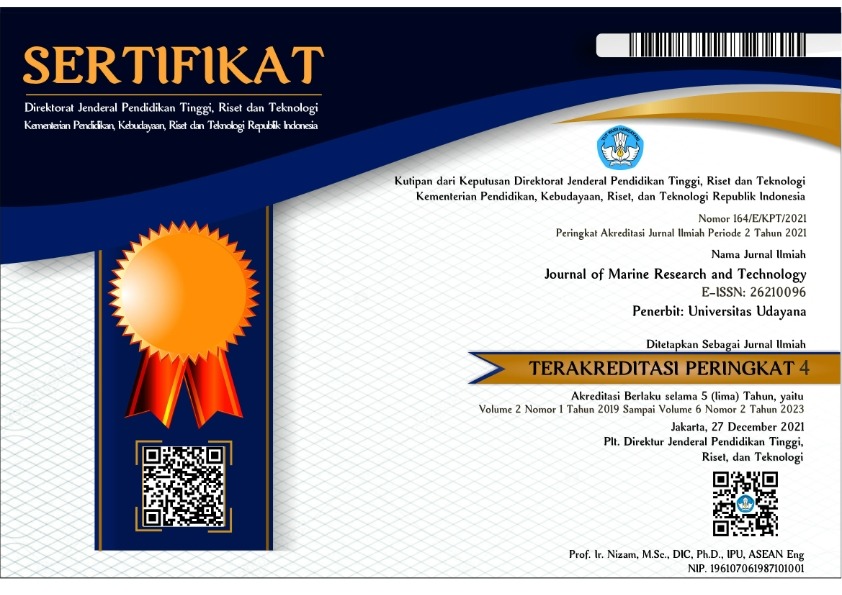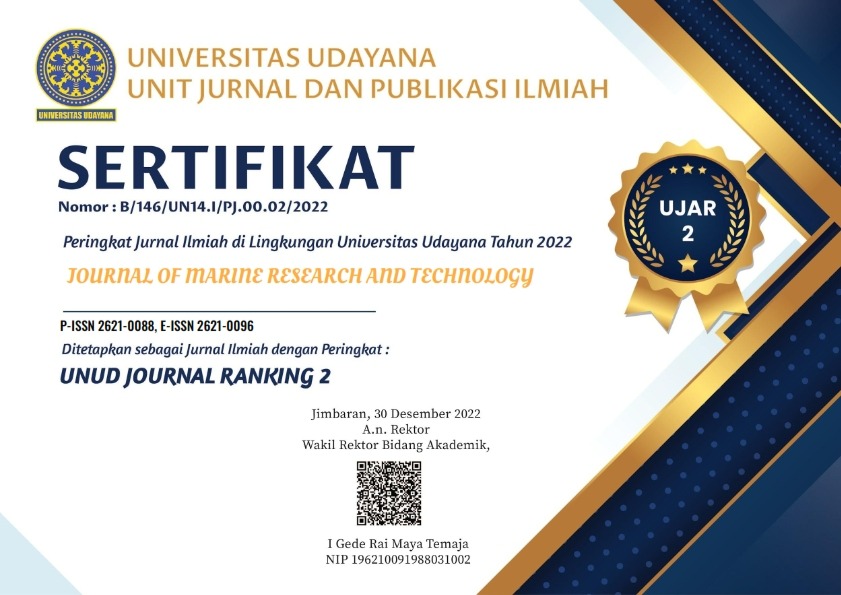Pergerakan Sampah Laut Yang Berasal Dari Sungai Di Perairan Selat Badung Dengan Pemodelan Numerik
Marine Debris; Badung Strait; FVCOM; Lagrange
Abstract
The issue of marine waste has become a global concern due to its impact on polluted biological systems. This occurs because, many individuals still believe that the ocean can handle waste on its own, so they toss trash into the waterway, ending th seas. There has been some research on marine flotsam and jetsam, but little research has been conducted on the distribution of marine debris and jetsam in the waters and along the coast of Badung Strait. This investigation seeks to determine the movement of marine debris and jetsam in the seas and along the coast of the Badung strait during the autumn season. The Limited Volume Coastal Sea Demonstrate (FVCOM) method induces 3D current patterns and particle dispersion patterns derived from 3D Lagrangian Molecule Simulations. As a result of the development of wind and currents, the way of flotsam and jetsam dispersion in the Badung Strait during the westerly season was primarily eastward. The pattern of flotsam and jetsam dispersion within the Badung Strait during the western season was primarily eastward due to the development of winds and currents. Additionally, marine flotsam and jetsam particles move along Badung Strait’s coastline to the coastline of Nusa Penida. In addition, Karangasem Rule, specifically the waters of Melanting Cape and Bugbug Cape, is home to an intriguing area for trash accumulation. This occurs because the shape of the shoreline, which is typically depressed, can trap flotsam and jetsam carried by water streams. In addition, the longer waste particles remain in the water, the more likely they are to be consumed by marine biota that cannot differentiate between their prey and marine waste, particularly filter-feeding marin animal
Downloads
References
Adibhusana, Made Narayana., I. G. Hendrawan, I W. G. Astawa Karang. 2016. Model Hidrodinamika Pasang Surut di Perairan Pesisir Barat Kabupaten Badung, Bali. SKRIPSI. Universitas Udayana. Bali.
Anom, I.B. Andika Putra., I. G. Hendrawan, I. D. N. Nurweda Putra. 2020. Studi Lama Waktu Tinggal Partikel di Kawasan Perairan Nusa Penida, Bali. Journal of Marine Research and Technology. Universitas Udayana. Bali.
Azis, M. F. 2006. Gerak Air di Laut. Oseana, 31(4), 9-21
Chen, Changsheng., Robert C. Beardsley and Geoffrey Cowles. 2006. An Unstructured Grid, Finite-Volume Coastal Ocean Model FVCOM User Manual. FVCOM User Manual.
Chung, D.H., Duyen, Nguyen T.K. 2012. Sensitivity of Lagrangian Particle Tracking Based on a 3D Numerical Model. Journal of Modern Physics, 3, 1972-1978.
Husrin, S., Wisha, U. J., Prasetyo, R., Putra, A., dan Attamimi, A. 2017. Characteristics of Marine Litters in the West Coast of Bali. Jurnal Segara, 13(2).
Lebreton, L. M., Greer, S. D., dan Borrero, J. C. 2012. Numerical Modelling of Floating Debris in the World’s Oceans. Marine Pollution Bulletin, 64(3), 653- 661.
Purba, N.P., W.S. Pranowo, S.M. Simanjuntak, I. Faizal, H.H. Jasmin, D.I. Handyman, P.G. Mulyani. 2019. Pemodelan Lintasan Sampah Mikro di Kawasan Konservasi Perairan Nasional Laut Sawu, Nusa Tenggara Timur. Depik Jurnal Ilmu-Ilmu Perairan, Pesisir dan Perikanan, 8(2): 125-133.
Purba, P. Noir. 2017. Status Sampah Laut Indonesia. FPIK-UNPAD
Soliwoda, J., 2014. Methods of Vessel Casualty Process Assessment. TransNav: International Journal on Marine Navigation and Safety of Sea Transportation, 8.
Sugiono. 2012. Metode Penelitian Kuantitatif Kualitatif dan R&D. Bandung : Alfabeta.
Theoyana, T. A., Pranowo, W. S., Anastasia R.T.D.K., Purwanto. 2015. Karakteristik Arus Pasang Surut di Selat Badung. Segara. Semarang.
Zambianchi E., Trani M., dan Falco P. 2017. Lagrangian Transport of Marine Litter in the Mediterranean Sea. Front. Environ. Sci. 5:5. doi: 10.3389/fenvs.2017.00005
Zhao, E. J., Mu, L., Qu, K., Shi, B., Ren, X. Y., dan Jiang, C. B. 2018. Numerical Investigation of Pollution Transport and Environmental Improvement Measures in a Tidal Bay Based on a Lagrangian Particle-Tracking Model. Water Science and Engineering, 11(1), 23-38.
Copyright Notice
The copyright to this article is transferred to Journal of Marine Research and Technology (JMRT). The copyright transfer covers the exclusive right and license to reproduce, publish, distribute and archive the article in all forms and media of expression now known or developed in the future, including reprints, translations, photographic reproductions, microform, electronic form (offline, online) or any other reproductions of similar nature.






